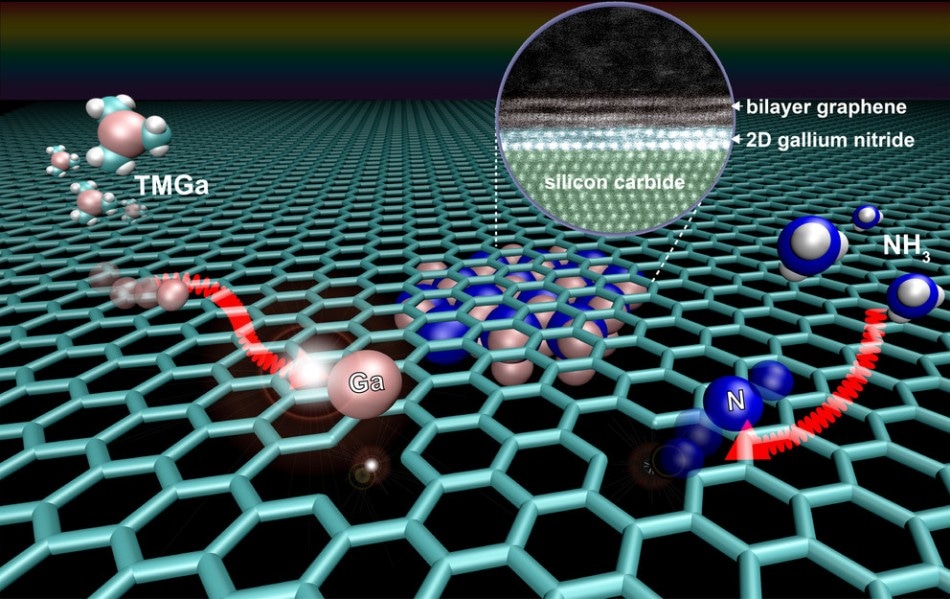Aug 30 2016
 An illustration of the Migration Enhance Encapsulated Growth (MEEG) process to stabilize novel wide-bandgap two-dimensional nitride semiconductors that are not naturally occurring. MEEG is facilitated by defects in the graphene lattice that act as pathways for intercalation. When the gallium and nitrogen atoms meet at the graphene/SiC interface, they chemically react to form two-dimensional gallium nitride.
(Image credit: Z. Al Balushi and Stephen Weitzner / Penn State MatSE)
An illustration of the Migration Enhance Encapsulated Growth (MEEG) process to stabilize novel wide-bandgap two-dimensional nitride semiconductors that are not naturally occurring. MEEG is facilitated by defects in the graphene lattice that act as pathways for intercalation. When the gallium and nitrogen atoms meet at the graphene/SiC interface, they chemically react to form two-dimensional gallium nitride.
(Image credit: Z. Al Balushi and Stephen Weitzner / Penn State MatSE)
According to Penn State materials scientists, their recently discovered 2D material creating technique could pave the way for new and extraordinary properties, mainly in a class of materials known as nitrides.
This is the first time 2D gallium nitride was grown using graphene encapsulation. It could result in applications in advanced electronics, deep UV lasers, and sensors.
These experimental results open up new avenues of research in 2D materials. This work focuses on making 2D gallium nitride, which has never been done before.
Joshua Robinson, Associate Professor, Penn State
Gallium nitride in its 3D form is said to be a wide-bandgap semiconductor. Wide-bandgap semiconductors are essential for high power, high frequency applications.
When gallium nitride is grown in its 2D form, it changes from a wide-bandgap material to an ultrawide-bandgap material, efficiently tripling the energy spectrum it can function in, including the whole visible, UV, and infrared spectrum. This research will particularly impact electro-optic devices that control and transmit light.
"This is a new way of thinking about synthesizing 2D materials," said Zak Al Balushi, a Ph.D. candidate coadvised by Robinson and Joan Redwing, professor of materials science and engineering and electrical engineering. Al Balushi is lead author on a paper appearing online today (Aug.29) in the journal Nature Materials titled "Two-Dimensional Gallium Nitride Realized via Graphene Encapsulation."
We have this palette of naturally occurring 2D materials, but to expand beyond this, we have to synthesize materials that do not exist in nature. Typically, new material systems are highly unstable. But our growth method, called Migration Enhanced Encapsulated Growth (MEEG), uses a layer of graphene to assist the growth and stabilize a robust structure of 2D gallium nitride.
Zak Al Balushi, Ph.D. Candidate, Penn State
The graphene is grown on a substrate of silicon carbide. This is a technologically significant substrate that is used extensively in industry for radar, LEDs, and telecommunications.
Upon heating, the silicon on the surface decomposes, leaving behind a carbon-rich surface that can reconstruct into graphene. The benefit of creating the graphene in this manner is that the interface where the two materials meet is completely smooth.
Robinson believes that with 2D gallium nitride, adding a graphene layer makes all the difference. Graphene, a one-atom-thick layer of carbon atoms, is well-known for its extraordinary strength and electronic properties.
"It's the key," Robinson says. "If you try to grow these materials the traditional way, on silicon carbide, you normally just form islands. It doesn't grow in nice layers on the silicon carbide."
When gallium atoms are introduced into the mix, they travel through the graphene and develop the middle layer of a sandwich. The graphene floats on top. When nitrogen atoms are introduced, a chemical reaction occurs that converts the nitrogen and gallium into gallium nitride.
The MEEG process not only produces ultra-thin sheets of gallium nitride but also changes the crystal structure of the material, which may lead to entirely new applications in electronics and optoelectronics.
Joan Redwing, Professor, Penn State
The other coauthors include Ke Wang, Rafael Vila, Sarah Eichfield, Yu-Chuan Lin and Shruti Subramanian of Penn State, Ram Krishna Ghosh and Suman Datta of Notre Dame, Joshua Caldwell, U.S. Naval Research Laboratory, Xiaoye Qin and Robert Wallace The University of Texas at Dallas and Dennis Paul, Physical Electronics USA.
The Asahi Glass Co., Ltd, Japan, and the U.S. National Science Foundation provided financial assistance for this project. The NSF Materials Science and Engineering Center at Penn State provided funding for Al Balushi. Other funding was offered by the Alfred P. Sloan Foundation, the Penn State Materials Characterization Laboratory and the Center for Low Energy Systems Technology (LEAST), funded by the Semiconductor Research Corporation and DARPA.